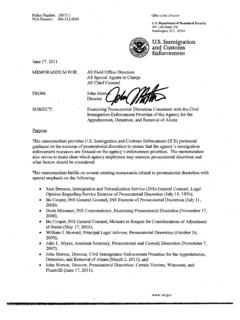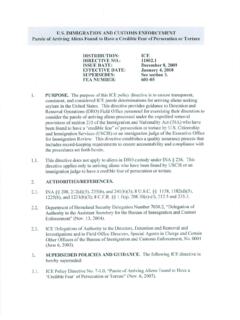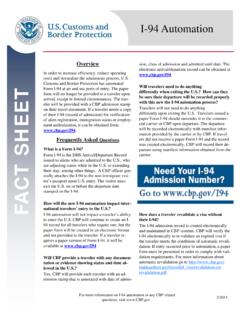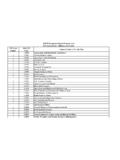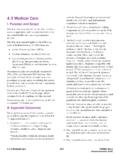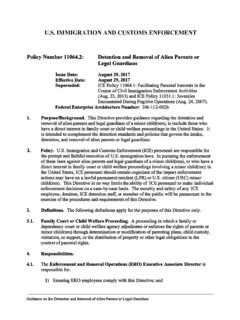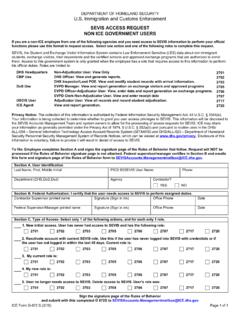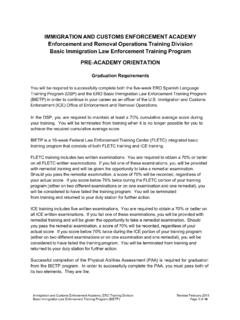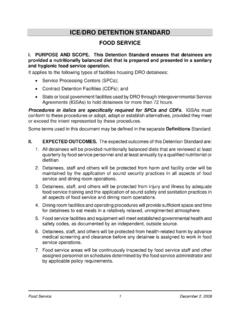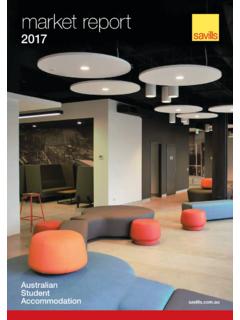Transcription of BIANNUAL REPORT ON INTERNATIONAL STUDENT …
1 1 SEVIS by the Numbers | April 2018 BIANNUAL REPORT ON INTERNATIONAL STUDENT TRENDSA p r i l 2018 NUMBERS SEVIS BY THE2 SEVIS by the Numbers | April 2018 Executive SummaryBackgroundThe STUDENT and Exchange Visitor Program (SEVP) is part of Immigration and Customs Enforcement s (ICE) Homeland Security Investigations within the Department of Homeland Security (DHS). SEVP manages the STUDENT and Exchange Visitor Information System (SEVIS), the web-based system DHS uses to maintain and manage information on the nonimmigrants whose primary purpose for coming to the United States is to study. A nonimmigrant is any foreign national who temporarily visits the United States to fulfill a specific purpose ( , tourism, business, study). SEVP acts as a bridge for organizations and individuals with an interest in information about nonimmigrants in the following categories:SEVP oversees F and M students and their dependents, as well as the schools that enroll them, for compliance with laws and regulations governing INTERNATIONAL students studying in the United States.
2 The Department of State manages the J-1 exchange visitor program. Both SEVP and the Department of State use SEVIS to maintain critical information that allows DHS to protect national security while supporting the legal entry of INTERNATIONAL students and exchange visitors. F-1 students Nonimmigrants whose primary purpose is to complete an academic course of study at an SEVP-certified school or program. M-1 students Nonimmigrants whose primary purpose is to complete a vocational course of study at an SEVP-certified school or program. J-1 EXCHANGE VISITORS Nonimmigrants selected to participate in a Department of State-designated exchange visitor program. SEVP-CERTIFIED SCHOOLS are eligible to enroll INTERNATIONAL students8,744OF SEVP-CERTIFIED SCHOOLS enroll 50 or fewer F & M students76%3 SEVIS by the Numbers | April 2018 SEVIS by the NumbersSEVIS by the Numbers is a BIANNUAL REPORT highlighting key SEVIS data to illustrate trends, values and information on INTERNATIONAL students studying in the United States.
3 The REPORT includes the following sections:TrendsThis SEVIS by the Numbers REPORT uses real-time SEVIS data from March 5, 2018, and compares data from March 2017 to March 2018. During this reporting period, the total number of SEVIS records for active F and M students decreased by percent, from 1,208,039 in March 2017 to 1,201,829 in March 2018. The J-1 exchange visitor population increased by 4 percent from 201,408 exchange visitors in March 2017 to 209,568 visitors in March , as of March 5, 2018: students Shares data on INTERNATIONAL students who come to the United States to study. SCHOOLS Shares data on SEVP-certified schools that enroll INTERNATIONAL students in the United States. STATES AND TERRITORIES Shares data about INTERNATIONAL STUDENT demographics within individual by the Numbers | April 2018 StudentsOverviewDuring the March 2017 to March 2018 reporting period, the total number of F and M INTERNATIONAL students decreased by 6,210 ( percent) and J-1 exchange visitors increased by 8,160 (+4 percent).
4 While both male and female students come to the United States to advance their education, 43 percent of F and M INTERNATIONAL students were female. However, 54 percent of J-1 exchange visitors were students in Higher EducationMost F and M students come to the United States to take part in the higher education system. Roughly 85 percent of all F and M students were enrolled in associate, bachelor s, master s or doctoral programs certified by SEVP. Specifically, there were 1,019,333 degree-seeking INTERNATIONAL students in the United States higher education system, which is a percent increase from March largest growth and decline came from students seeking doctorate degrees and associate degrees, respectively. Doctorate degree programs saw a 4 percent increase (+6,241), while associate degree programs saw a 5 percent decrease (-4,793).
5 students seeking bachelor s and master s degrees stayed stable, with the former growing less than a percentage point (+2,630) and the latter growing by just 1 percent (+4,045). Above are the percentage breakdowns of INTERNATIONAL students enrolled in the higher education s and Master s StudentsBachelor s and Master s StudentsBachelor s and Master s Students169,359 148,875 135,608 ENGINEERINGCOMPUTER AND INFORMATION SCIENCES AND SUPPORT SERVICESBUSINESS, MANAGEMENT, MARKETING AND RELATED SUPPORT SERVICES5 SEVIS by the Numbers | April 2018 Associate DegreesForty-nine percent of INTERNATIONAL students seeking associate degrees were female. Fifty percent of INTERNATIONAL students seeking associate degrees studied either business (23,472 students ) or liberal arts (19,676 students ).
6 Other popular areas of study include computer and information sciences, as well as health care professions. Bachelor s and Master s DegreesThere were 785,435 F-1 students in the United States seeking either a bachelor s (402,293 students ) or master s degree (383,142 students ) and 43 percent of these students are female. These two levels of education were the most popular among INTERNATIONAL students coming to the United States and together accounted for 65 percent of the INTERNATIONAL STUDENT population. Fifty-eight percent of students pursuing degrees at these levels studied one of the three following areas: business, engineering or computer science. Above are the three most popular areas of study for INTERNATIONAL students pursuing bachelor s and master s Students45, Students19,24914,671 PHYSICAL SCIENCESBIOLOGICAL AND BIOMEDICAL SCIENCES6 SEVIS by the Numbers | April 2018 Doctorate DegreesThe INTERNATIONAL STUDENT population studying at the doctorate degree level had the largest gender discrepancy, as only 39 percent of these students are female.
7 Unlike other education levels, business was not one of the more popular areas within this category. Instead, the majority of of F-1 doctoral candidates pursued degrees in the science, technology, engineering and mathematics field. With the largest participation in programs related to engineering, physical sciences, and biological and biomedical are the three most popular areas of study for INTERNATIONAL students pursuing doctorate by the Numbers | April 2018 INTERNATIONAL students from Around the WorldAside from Antarctica, F and M students come from every continent in the world, with more than 229 countries and territories represented in the academic community. Although Asia continually sends the largest number of INTERNATIONAL students , only South America, Africa and Australia/Pacific Islands saw growth in the number of students coming to the United States during the reporting year.
8 Figure 1 illustrates the overall population and growth/decline rate of each continent from March 2017 to March NOTE: Continent information within this REPORT was compiled using the United Nation s composition of macro geographical (continental) regions, geographical subregions, and selected economic and other by the Numbers | April 2018 FIGURE 1 Above are the growth/decline rates and absolute increase and decreases for each continent over the course of the reporting period (March 2017 to March 2018). To explore exact figures of the entire STUDENT populations from these regions, including specific countries, please visit Mapping SEVIS by the Numbers on Study in the by the Numbers | April 2018 AfricaWhile the overall F and M STUDENT population coming from Africa grew by more than 750 students from March 2017 to March 2018, this growth was not evenly distributed.
9 Eastern and Western African countries like Nigeria (+1,128), Kenya (+212) and Ghana (+170) sent substantially more students , while Northern African countries sent far fewer. Specifically, the STUDENT populations from Libya (-299), Angola (-176) and Morocco (-170) saw the steepest 2 Above are the African countries that saw the greatest fluctuation in the number of students coming to the United States in the reporting period (March 2017 to March 2018). To explore more year-over-year comparisons from all over the world, please visit the Mapping SEVIS by the Numbers - Continent View on Study in the States. 10 SEVIS by the Numbers | April 2018 AsiaForty-nine percent of the F and M STUDENT population in the United States hailed from either China (377,070 students ) or India (211,703 students ), and interest continues to grow.
10 Over the reporting period, both China and India saw proportional growth between 1 and 2 percent, with China sending 6,305 more students and India sending 2,356 more students . It is this level of participation from China and India that makes Asia far and away the most popular continent of origin. In fact, 77 percent of all INTERNATIONAL students in the United States call Asia home. Despite steady growth from the two most popular nations, there was a slight decrease in the number of Asian students coming to study in the United States over the reporting period. As illustrated in Figure 3, the sharp decline in the number of students from Saudi Arabia (-9,971), South Korea (-5,488), and Yemen (-396) outweighed the rapid growth in the number of students coming from Pakistan (+448), Burma (+206) and Cambodia (+109).
